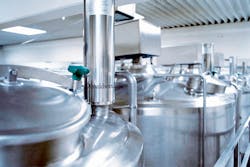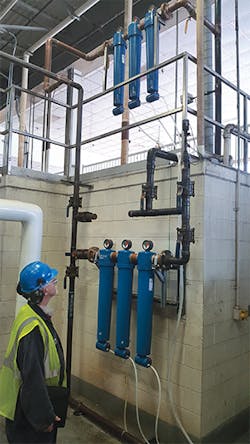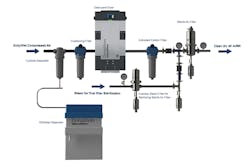Pharmaceutical processing requires the highest level of aseptic conditions. Contamination is a chief concern and managing microorganisms is a top priority.
A primary source of contaminants can be the water, steam, gases and compressed air a process uses. These "utilities" can carry oil, dirt, debris and microorganisms into your product, unless they are properly filtered.
There are two basic principles to observe in pharmaceutical filtration:
Focus upstream. The farther upstream a contaminant enters, the more opportunities it has to propagate throughout the process. If there is an ingress of a harmful bacteria, the bacterial colonies have more time and space to propagate further. Once they surface downstream, you’ll have to work your way back to discover the source and recertify your process to run again. To reduce time, energy and cost, it makes sense to capture and isolate contaminants as early as possible.
Use redundancy. Plan prefiltering, intermediate filtering and final product filtering in a series on the line. Staged filtering provides a higher level of protection and saves costs by reducing filter overload (and replacements) on the most expensive elements. Redundancy aims to produce pure fluids at a lower cost (see Figure 1).
Figure 1. This air filtration system has a duplex design — redundancy — as an extra precaution.
With those principles in mind, here are specific critical control points for filtration.
Utility area prefiltration
Begin filtering in the utility or bulk storage area, where municipal water is drawn in, steam is generated or produced, or gases such as nitrogen are stored. There are abundant opportunities here for contamination. Boilers and generators can corrode and shed metal flakes as they age. Even routines such
disconnecting and reconnecting nitrogen tanks can expose the line to impurities in ambient air.
Prefilters on water, gas or steam supplies will help reduce these risks. Install a 10-micron filter on each source before the utilities branch into separate lines for industrial use, like sterilize in place (SIP)/clean in place (CIP) cleaning, and process use. A 10-micron element will help catch a high percentage of the contaminants from the supply sources before they enter the facility.
Compressed air drying
Compressed air requires a series of drying steps before it can be used in processing. All intake air has humidity, and most compressors operate with lubricants. Since water and oil make an ideal organic diet for microorganisms, keeping air dry and oil-free helps keep it sterile.
The refrigerated dryer placed just after your air compressor will condense and remove a high volume of humidity — but not of all it. These further treatments are recommended: 1) a cyclone separator to spin out remaining bulk water; 2) a coalescing filter that extracts more difficult aerosols; and 3) an adsorption air dryer that uses a desiccant material to remove any remaining water vapor.
In a coalescing filter, look for pleated filters with a free fiber structure. They will perform better and more cost-effectively than wrapped or resin-bonded media, which have glues that take up space and block airflow.
If you have seasonal swings in relative humidity, size the compressed air-drying equipment to handle peak demands. Also, work to keep the system from reaching its dew point — the temperature that produces condensation in the first place (see Figure 2).
Figure 2. Compressed air-drying steps
Process line filtration
Formulation areas and fill lines are the next critical control points. Wherever the product is exposed to steam, liquid, nitrogen gas or compressed air, install a point-of-use sterile filter.
Sterile applications, whether liquid or air, usually require a sterile-grade liquid filter rated at 0.2 micron. The market offers filters "rated" much lower, such as 0.01 micron, but 0.2 micron is the most penetrating particle size and the point of lowest efficiency. Be sure to confirm the supplier has had its filters independently tested and qualified as a sterile filtrate, according to ASTM F-838 05. It may be surprising to know that a "0.01 micron-rated" filter might actually have very low/unacceptable performance at 0.2 micron.
From the primary API formulation area, the product moves into intermediate processing, where other ingredients may be added: liquid propellants for aerosols, moist coatings, sterile water, etc. Wherever air or liquids help introduce these additives, there are new opportunities for contamination that should be addressed with precautionary filtering.
Again, risks can arise within your system. Our team has seen instances where a new valve or hose was installed using the wrong kind of gasket or O-ring. Over time, it degraded and flaked material.
Tank vent filtration
Holding tanks are another significant risk area. As ingredients, API formulations, or water for injection (WFI) is stored, the tanks can be breeding grounds for microorganisms picked up from ambient air, personnel or earlier piping through the system.
As a protective measure — and to counterbalance pressure as the tank empties and fills — processors often inject a blanket of inert nitrogen or clean dry air (CDA) over the product. Both CDA and nitrogen gas should be filtered as they enter the tank. A sterile air vent filter of 0.2 microns is recommended.
When choosing tank vent filters, make certain they are compatible with the tank conditions. In a hot WFI tank, a common polypropylene-caged filter tends to "wet-out" with condensation, creating wet surface tension that blocks airflow through the filter. Some processors bring in a secondary heat wrap to control condensation. In addition, a sterilizing element with hydrophobic media that resists condensation is important. Options include a stainless steel cage with all-PTFE media — such as the P-SRF X by Donaldson — specifically designed to withstand high tank temperatures (see opening photo).
If there are tanks at several locations along the process line, use a new round of gas or CDA blanket filters on each set of tanks.
Conclusion
The aim of prefiltering, intermediate filtering and final product filtering is redundancy. When a process involves costly ingredients and managing microorganisms is important, as it is in pharmaceuticals, filtering "early and often" is a good policy.
As a final word of caution, be sure to work with a trustworthy filtration partner. Every processing facility is different and will pose unique questions: What’s the right micron size and filter efficiency at a certain location? How many CIP and SIP sterilization cycles can an element tolerate? Are the chemical properties of the housing and all components non-reactive to my chemicals? If they are stainless steel, do they have the right polish and weld technique to avoid harbor points for bacteria?
Of course, you know your process best and the requirements that your process will bring to its filtration design. It is important to work with a representative of an experienced, reputable filtration company who can understand those requirements and provide products to address those needs.
Chris Lehmann is the North American product manager for Donaldson Company’s Process Filtration Division. His 10 years of industrial process experience includes pharmaceutical and chemical processing.
Colter Marcks is a lead development engineer in Donaldson Company’s Process Filtration Division, with expertise in applications and regulations related to liquid filtration, culinary steam and sterile air production.




